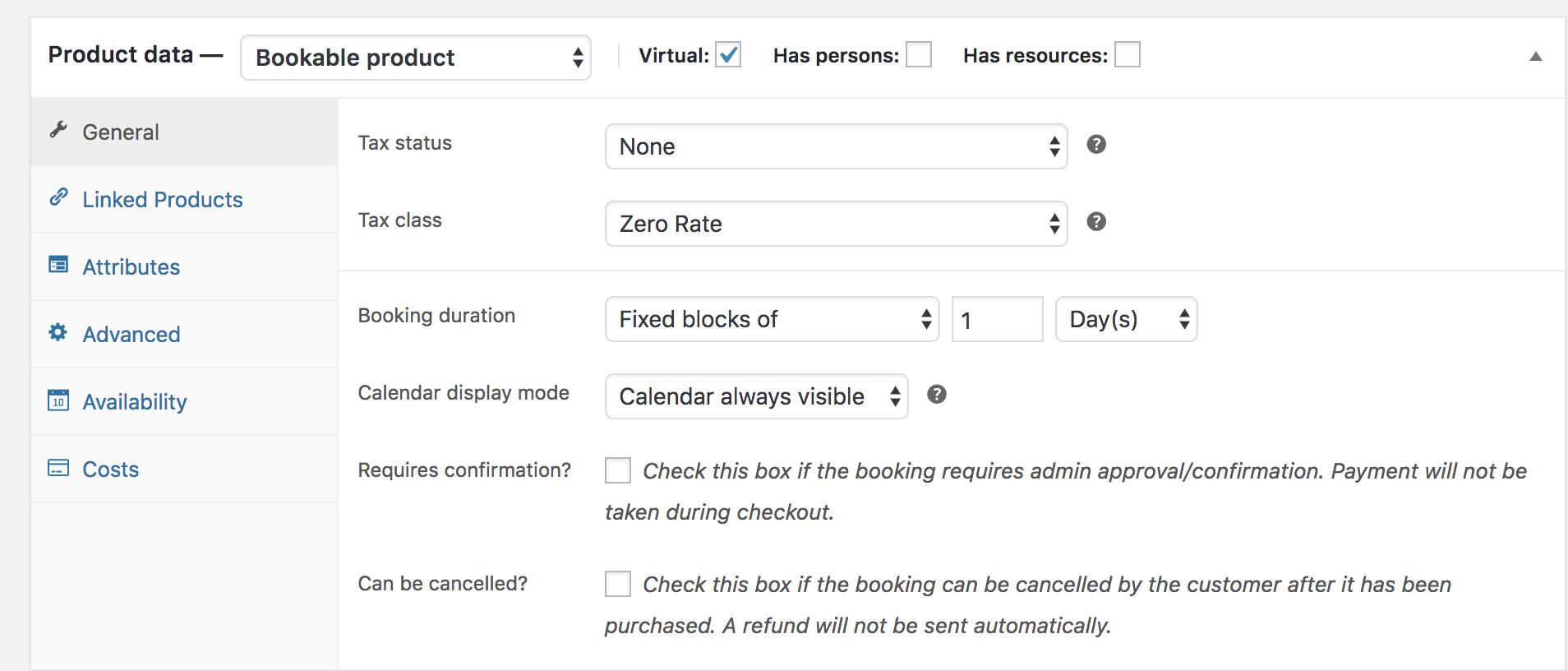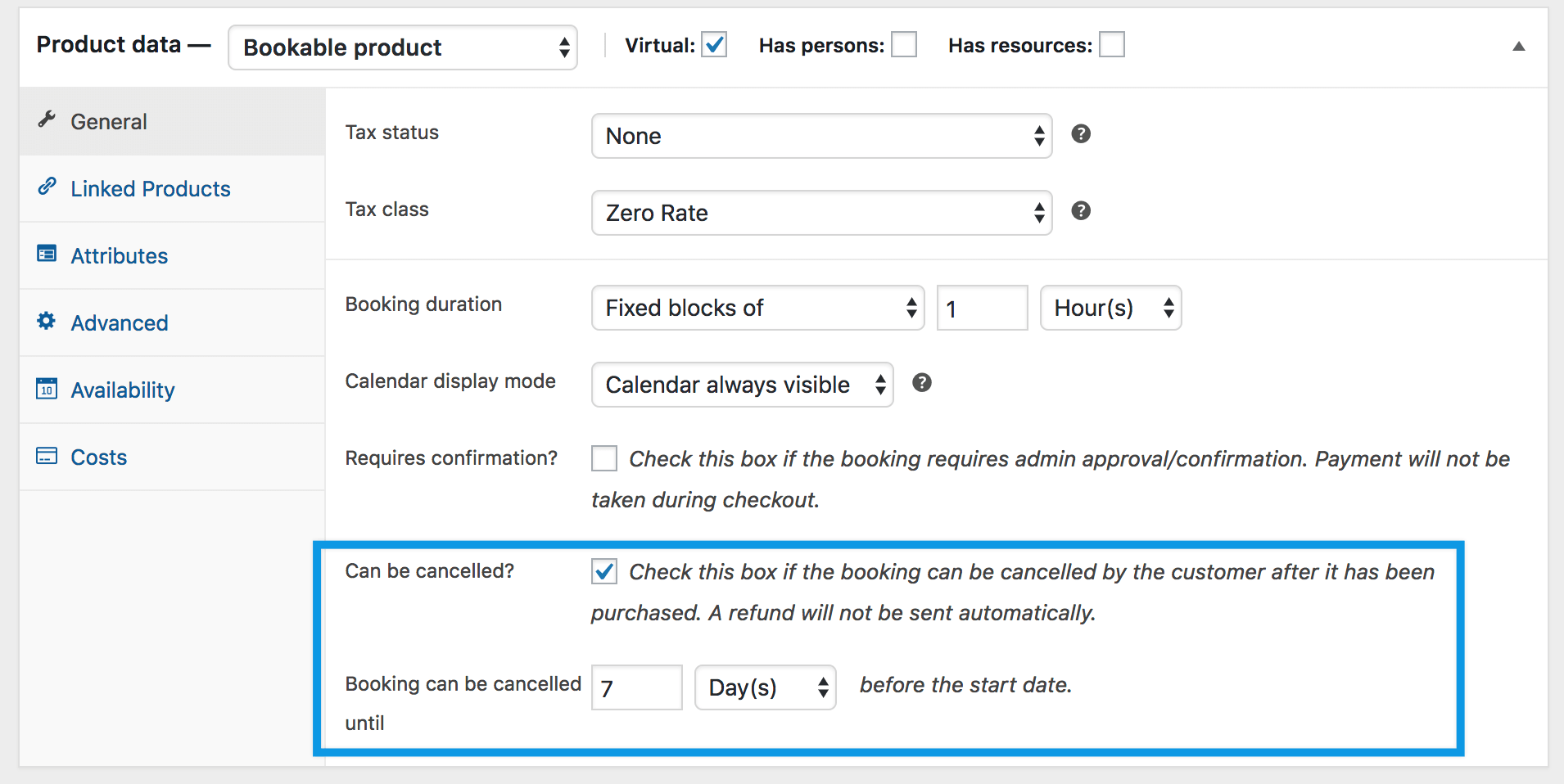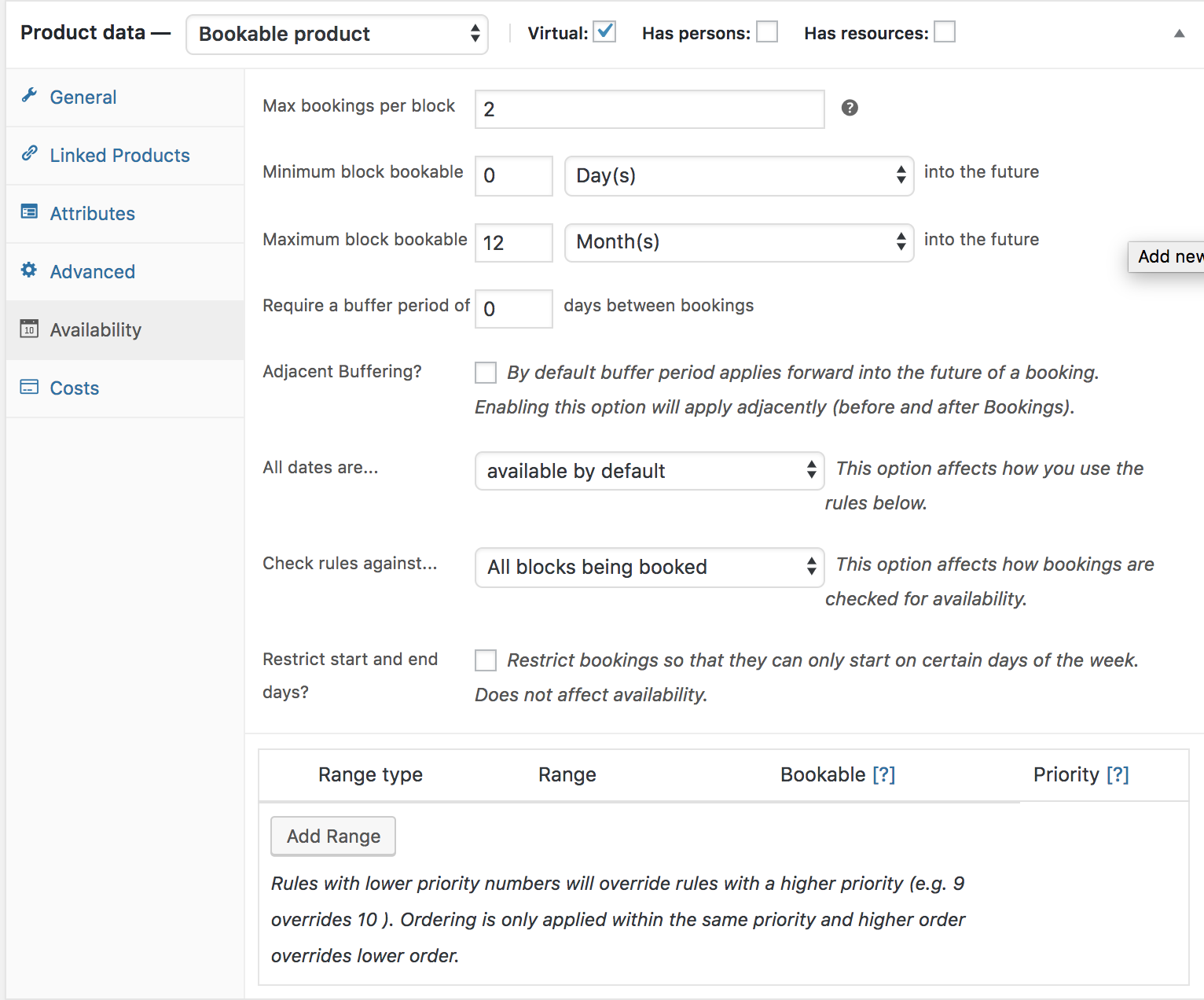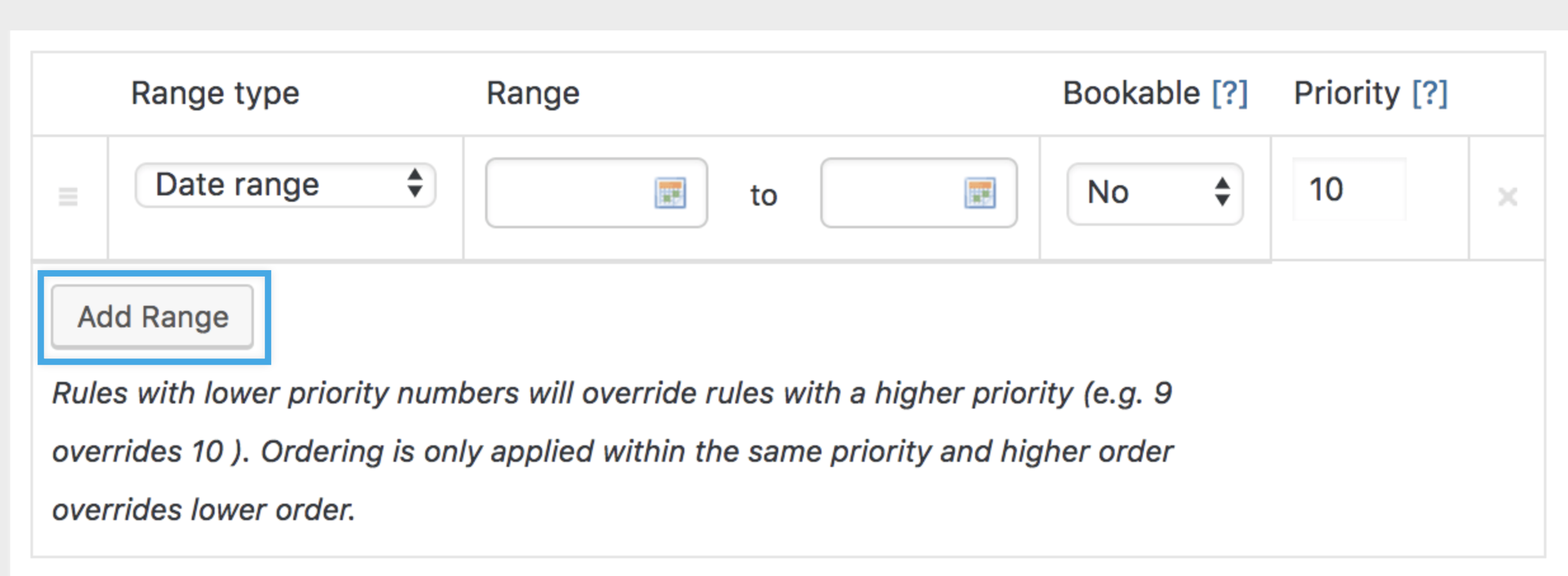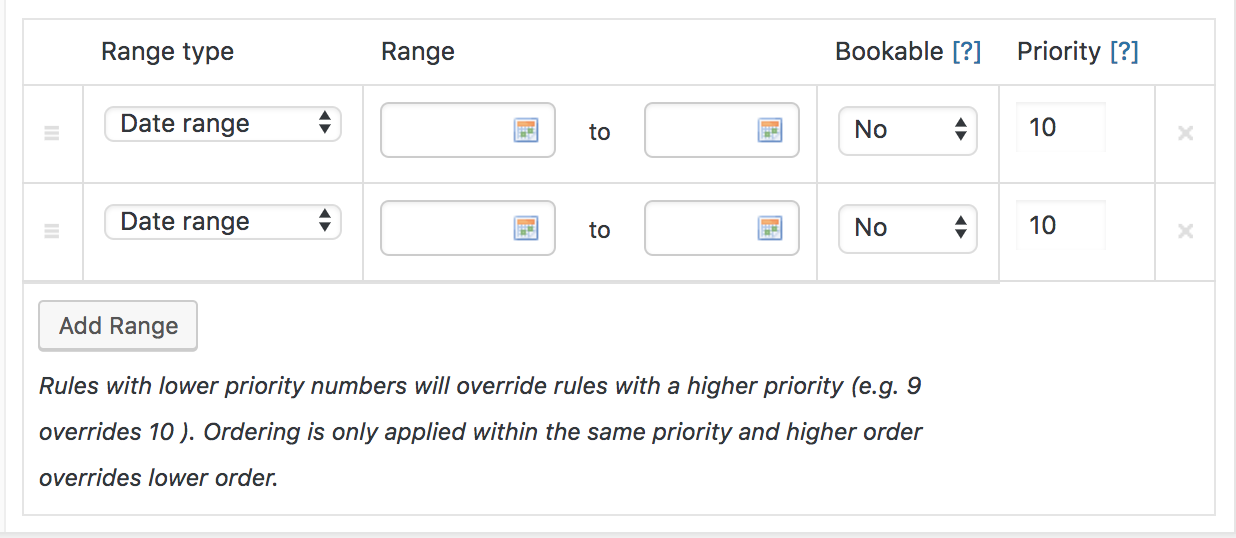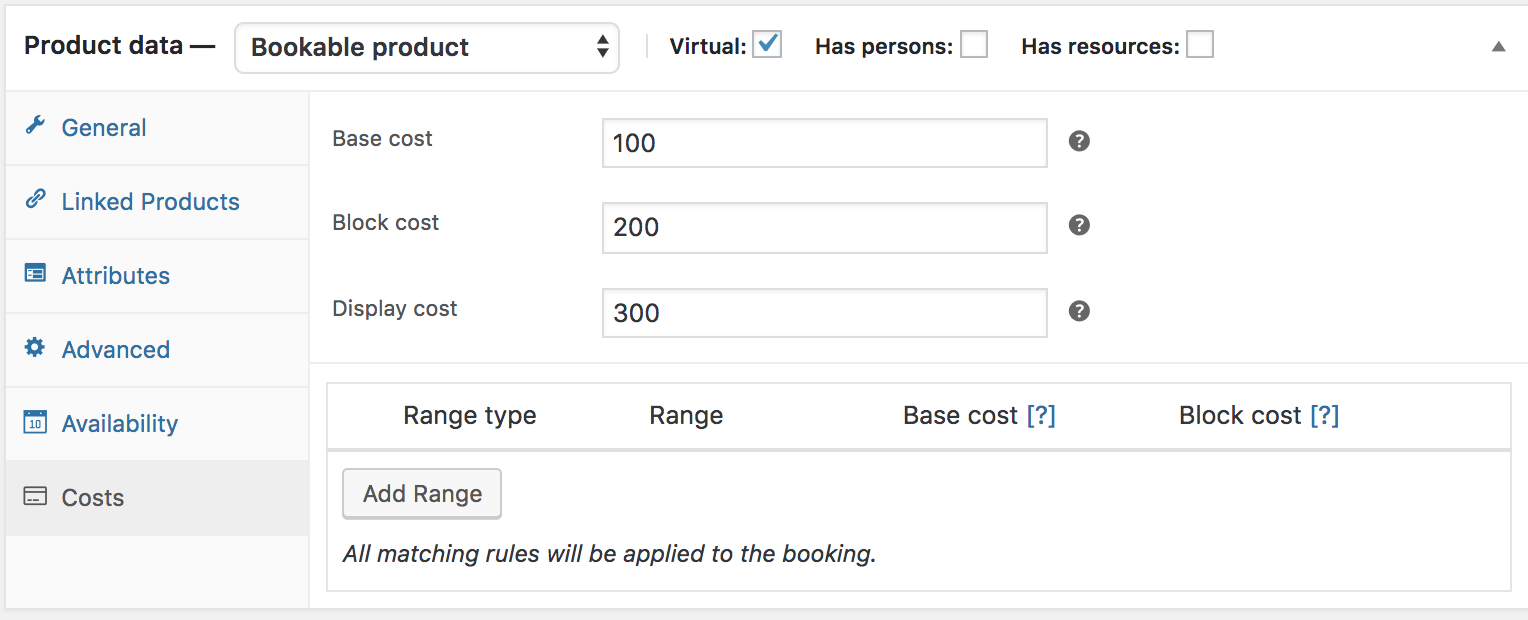How to set up a time-based product that allows customers to book classes, appointments, accommodation and more
Save time and effort by letting customers book at their convenience
Let your customers book reservations, appointments, or rentals on their own – no phone calls required. Save yourself time and fill up your calendar by letting your site do the work for you.
Let customers book classes, schedule appointments, or reserve items

Whatever options you want to offer to your customers, Bookings makes it possible:
- Define set options, like fixed time slots for a class, appointment or guided tour
- Let customers choose the times that work best by giving them the flexibility to book whatever range they need, like checking into a hotel
With either option, you can also block time off as un-bookable, leaving you time to take care of your other priorities and create buffers between bookings, to make sure the schedule works for you.
Get as specific as you want with your time slots—the extension allows for bookings in days, hours, even minutes.
Book one-on-one appointments or multi-person events

You can set the minimum and a maximum number of participants: limit a booking to one at a time for appointments or let multiple people reserve a class or tour.
Offer special pricing for groups, days, or individuals

Offer discounts for groups or people booking multiple slots, show lower prices for early birds, higher prices on weekends, or special prices for kids. Bookings lets you customize pricing any way you want.
Show availability in the customer’s time zone
If your services are online or if you’re shipping something to the customer, display your availability in the customer’s time zone so they book the time they really need. Whether bookings come from New York, New Mexico or New Zealand, they’ll be within the hours you set, so no surprise appointments!
It’s perfect for virtual classes, online appointments, or rentals that need to be delivered to the customer.
Require confirmation, offer free cancellations – it’s all up to you

Set up confirmations, allowing you time to review before making the booking official. Automatically send out reminders leading up to a booking to reduce no-shows, and set whether bookings can be cancelled.
Send reminders and reduce no-shows

Remind clients about their appointments with handy notification emails when a reservation is made, confirmed, and a day before the booking date.
If you’d like to do more, you can send a special reminder right from your site.
Never get double-booked
Avoid double bookings by assigning the needed resources to a particular booking. For example, if your 2:00 bride books a fitting and a stylist until 3:30, that stylist won’t appear available for the bride scheduling a fitting at 3:00. You’ll never have to worry about offering the same resource to two customers at the same time.
Manage your calendar, your way – including syncing with Google Calendar

Use the calendar view to see how your day or month is shaping up. Update existing bookings or availability, or filter to view specific services or resources.
Still have customers calling in to make bookings the old-fashioned way? Add them manually from the calendar while you’re on the phone.
Creating a Bookable Product
To accept bookings, you need to create a bookable product.
- Go to: Products > Add New. A familiar WooCommerce interface for product creation appears.
- Enter a title and description for your product.
- Scroll down to Product Data and select Bookable Product in the dropdown menu.
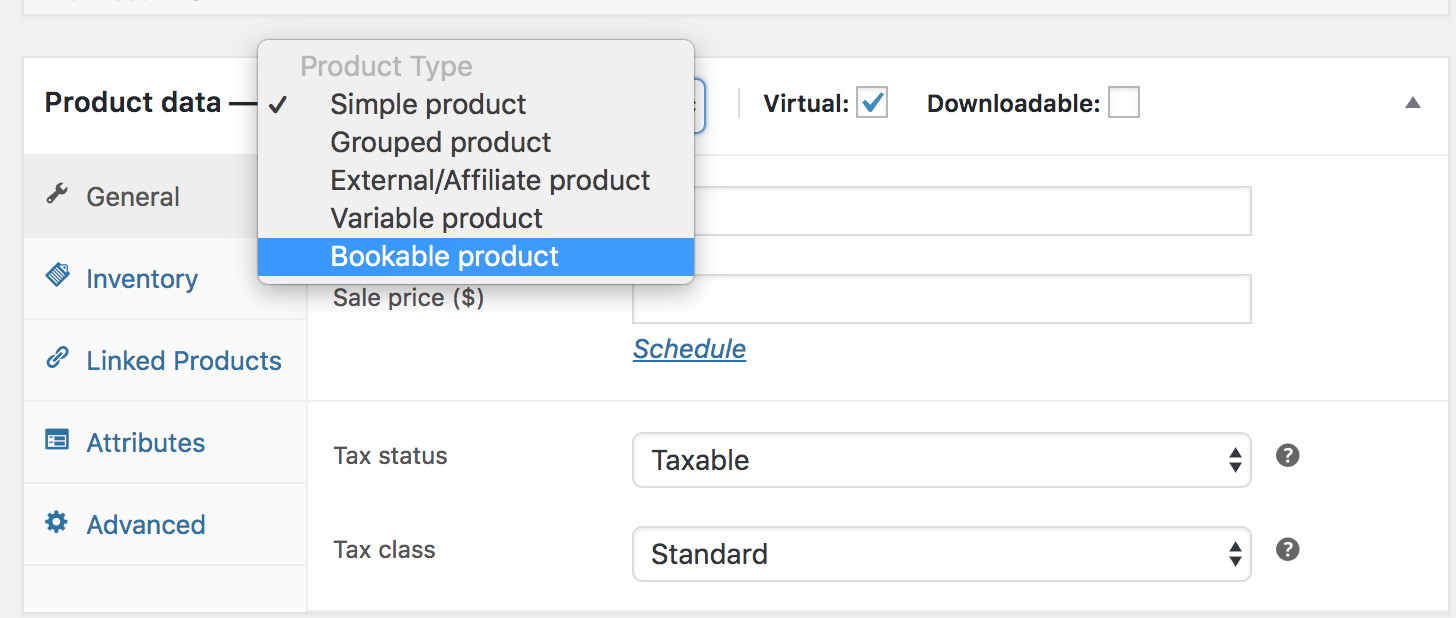
- Tick the Virtual checkbox, if your product does not require shipping. This omits the Shipping Costs tab from your product.
Fields will change to reflect bookable products.
General settings
The first settings are booking duration, calendar display and confirmation preferences.
Taxes
Select the appropriate Tax status and Tax class for this product, should you need to charge tax or not.
Booking duration
This determines how long a booking lasts. The duration can be admin defined (fixed block) or customer defined (they need to input on the front-end). Duration units can be Hours, Minutes, Days or Months.
Fixed blocks have a set duration that you define. The customer can only choose one block which will last the defined amount of time. For example hair dresser appointment lasts one hour and you can only book one at a time.
Customer-defined blocks have a set duration, but the customer can choose how many blocks they want. For example, the co-working space is rented out in hourly intervals, and the customer can define how many 1-hour blocks they would like to rent.
If you set your Booking duration to be customer defined:
- A minimum and maximum allowed value can be included in the General tab. This allows for a more flexible starting schedule.
- It is possible to use 30-minute blocks and set the minimum to 2 blocks. Your customers now need to book at least one hour, and can add increments of 30 minutes.
- A customer-defined duration with blocks in minutes/hours will display a dropdown.
Calendar display mode
Select Calendar always visible or Display calendar on click. By default the calendar is set to always show.
If the Booking duration is set to be Customer defined with a unit of Days, then another option will be shown to enable the calendar range picker. Enabling this allows customers to select a start date and an end date for their booking within the calendar itself.
Requiring Confirmation
If the booking needs to be reviewed by an Admin before confirmation, tick the Requires confirmation? checkbox. Rather than take payment at checkout, the user inputs details and submits them for approval.
To learn more, see Manage Bookings.
If the Requires Confirmation? checkbox is ticked:
- the Check Availability option will be the only payment gateway presented when checking out
- other items will be removed from the Cart when this bookable product is added to the Cart
Please note that the Check Availability “payment gateway” can’t be enabled/disabled under WooCommerce > Settings > Payments like other gateways can, and is displayed/hidden based purely on a Bookable Product requiring confirmation being in the Cart.
Once the booking is approved, the customer receives another email to then submit payment.
Allowing Booking Cancellation
You may choose whether you want the user to have the option to cancel their booking. After selecting the option Can be cancelled?, two fields appear that allow you to choose how many Minutes/Hours/Days/Months prior to the start date that customers can cancel a booking.
Availability settings
Availability (what slots can be booked) can be controlled via the Availability tab. The first options allow you define dates that can be booked:
Max bookings per block
This setting allows multiple bookings at the same time. With a fixed booking of 1 day and maximum bookings per block set to 2, then each day you can accept two bookings.
Minimum/Maximum block bookable into the future
If today is March 1 and you set minimum block bookable to 1 month into the future, then the first date a customer could book would be April 1. The same applies to the maximum date bookable.
Require a buffer period between bookings
Based on the unit of time set for the booking (minutes, hours or days), you can specify a period of time after a bookable slot that is unavailable for anyone else to book. For example, if you sell appointments in 1-hour blocks and wish to have a break of 1 hour between them, you can specify a buffer period.
If you prefer to add a buffer before and after your appointments, tick the Adjacent Buffering checkbox. This option adds the specified block both before and after each booking. Defining a buffer period of one hour between booking with adjacent buffering will result into 2 hours between bookings.
Buffer periods are always defined in the same time measurement (minutes, hours or days) chosen for blocks. If you want to have a 30-minute buffer between your 1-hour appointments, be sure to use 60-minute blocks instead of 1-hour blocks.
All dates are
Depending on how you want to set up availability, this option allows you to set available by default or not available by default. Available by default means all blocks are available and you can specifically turn some off with rules, where not available by default means all blocks are not available and must be turned on through availability rules.
Check rules against
You have two options:
- All blocks being booked – This checks all available blocks within a duration. For example if a customer chooses to book for 5 days and 1 block is equal to 1 day, it will check availability for all 5 days.
- Starting block only – This checks the first block the user selects. For example if a customer chooses to book for 5 days and 1 block is equal to 1 day, it will only check availability for the first day.
Restrict start and end days
Say you have a weekly rental, but you only allow customers to start their rental on Fridays.
- Tick the box.
- Select the day (in this case Friday), or day(s) you would like to restrict the booking to start on.
This does not affect availability; other days are still available, they just cannot be selected as the day(s) that bookings start on.
Custom Availability Range
You can set up specific availability rules, such as availability for:
- Months
- Day of the week
- Time
- Specific date
To add a rule, select Add Range:
A new row is created, where you can choose a range type, from/to, whether it’s bookable or not (yes or no) and a priority number.
The from/to values differ based on the range type:
- Date range – from/to will show a datepicker/calendar selection field
- Range of days – from/to will show a dropdown of days of the week (Monday to Sunday)
- Range of months – from/to will show a dropdown of months (January to December)
- Range of weeks – from/to will show a dropdown of weeks (1 to 52)
- Time ranges – from/to will show time inputs
- Date Range with time – period with a start date/time and an end date/time. Range applies from start time on the start day to end time on the end date.
- Date Range with recurring time – set based on a custom date range. Range is repeated on each day in the date range.
 Note that the time ranges are not opening hours, but booking hours. If you offer 1-hour time blocks and your shop is open from 9:00 am to 6:00 pm, your last booking is at 5:00 pm, not 6:00 pm.
Note that the time ranges are not opening hours, but booking hours. If you offer 1-hour time blocks and your shop is open from 9:00 am to 6:00 pm, your last booking is at 5:00 pm, not 6:00 pm.
By default, Global availability rules take priority over product level availability rules and product availability rules take priority over resource priority rules. The order can be changed using the priority numbers. A lower priority, irrespective of context, overrides any other context with higher priority number. For example, a 9 will always override 10, even if 10 is on the Global level.
Rows can be removed by clicking the X on the far right, or dragged and dropped to sort using the handle on the far left.
Also be aware that availability options can be set up globally if all bookable products share some dates. To read more about Global availability, see Booking Settings.
Costs for Bookable Products
Costs for specific slots are controlled from the Costs tab.
The two main costs you can add are Base cost and Block cost.
- Base cost is applied regardless of a customer’s choices on the booking form.
- Block cost is the cost per block that was assigned in the General tab. If a customer books multiple blocks, this cost is multiplied by the number of blocks booked.
Display cost does not affect the actual cost of the product. In the example above, the product page displays 300 on the frontend. The cost is displayed to the user on the frontend. Leave blank to have it calculated for you. If a booking has varying costs, the lowest available cost is shown and is prefixed with the word “From:”
Beneath the display cost, you have an area where you can define extra costs. This works similar to availability. Click Add Range to begin:
A row appears where you can input the range type, from/to and cost:
The from/to values differ based on the range type:
- Date range – from/to will show a datepicker field
- Range of months – from/to will show a dropdown of months (January to December)
- Range of weeks – from/to will show a dropdown of weeks (1 to 52)
- Range of days – from/to will show a dropdown of days of the week (Monday to Sunday)
- Time range – from/to will show time inputs
- Date range with time – set based on a custom date range
- Persons count – from/to will show number inputs
- Block count – from and to will show number inputs
Base cost and Block cost can be added, subtracted, multiplied or divided by the amount you enter. Since version 1.10.9, you can also directly set the costs applied for the rule.
Rows can be removed by clicking the X on the far right, or dragged and dropped to sort using the handle on the far left.
Persons
If the booking can be made for multiple persons at once, tick the Has persons checkbox. Once selected, a new tab appears:
You can set a min and maximum for persons. Similar to duration, the customer can input a value on the frontend booking form, if enabled.
Persons also impacts the following cost options:
- If multiple costs by person count is enabled, all costs are multiplied by the number of persons the customer defines.
- If count persons as bookings is enabled, the person count is used as the quantity against the block. Remember the max bookings per block setting above? That determines the upper limit for allowed persons per block. Once the limit is reached, more persons cannot book.
The Persons tab also allows you to define different prices depending on the person type. You might want to offer a different price for children or for teachers on a museum tour for example. To set up different person types, tick the Enable Persons Type checkbox in your Persons Tab:
Once you tick this checkbox, you have the option to add multiple types.
Give your Person type a name and define the cost for the type. Adding a description is optional.
You can define a minimum and a maximum number for each person type. For example, you could require at least one adult for each booking while making children optional (minimum 0). If you leave Max blank, there are no other restrictions than those of the bookable product itself.
Clicking the Unlink button will remove the person type from the product. The person type will still exist, but be hidden, this is so previously created bookings are not broken.
Resources
For added flexibility, WooCommerce Bookings supports Bookable Resources that can be booked independently within a bookable product. Tick the Has resources checkbox to enable a new tab:
There are two types of bookable resources:
- Customer selected – A booking form shows a dropdown list of resources that the customer can select.
- Automatically assigned – A resource is automatically assigned to a customer booking if available.
An example use case for a customer selected resource would be a room type, such as single and twin rooms.
An example use case for an automatically assigned resource would be a hair salon where the resources are staff and someone is assigned a booking. More at: Hair Salon – Bookings Use Case.
After enabling resources, choose your type. If you have chosen Customer selected be sure to give your resource a label. This is what is shown on the frontend booking form.
Resources can be used globally across multiple products. Even though a bookable product can have multiple resources associated with it, only one resource can be assigned per booking.


